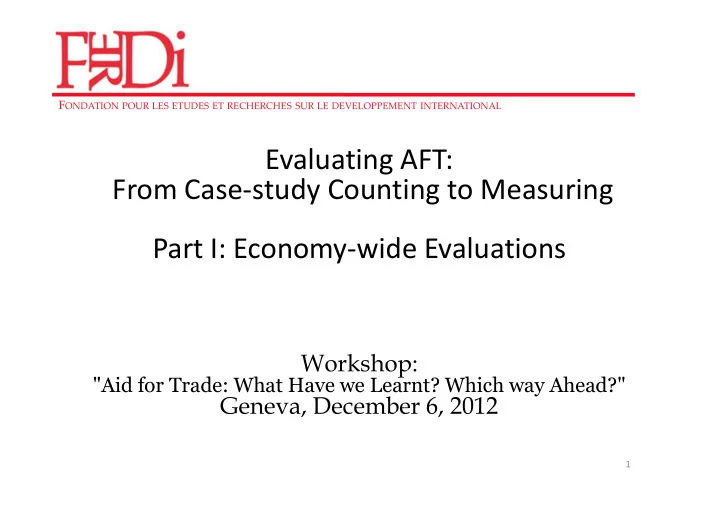

F ONDATION POUR LES ETUDES ET RECHERCHES SUR LE DEVELOPPEMENT INTERNATIONAL Evaluating AFT: From Case-study Counting to Measuring Part I: Economy-wide Evaluations Workshop: "Aid for Trade: What Have we Learnt? Which way Ahead?" Geneva, December 6, 2012 1
OUTLINE � Counting our way to quantitative results � AFT, trade Costs and Trade Linkages � Calibrated TC Estimates: (≈1/3 of observed Trade Growth) � Disentangling hard and soft: some examples � Competition in Logistics: Caribbean case study 2 2
T HE « BIG PUSH » HAS BEEN IN HARD ( INFRASTRUCTURE ) 3
C OUNTING OUR WAY TO QUANTITATIVE RESULTS � Messerlin et al. (2010) meta evaluation (word count) of 162 AFT projects in Ghana and Vietnam: Trade impact not considered, nor mention of WTO…rather mention of poverty reduction, gender… � Folletti-Newfarmer (2011) review of 269 case studies: less than 50% [25%] of 269 cases had output [outcome] indicators (see next slide). Only 4 reported on econometric studies… � Next slide: Counting outputs in infrastructure projects has not taken place…room for improvement � For both reviews, 5 times more reference counts to exports than to imports…. 4
«N OT EVERYTHING THAT CAN BE COUNTED COUNTS AND NOT EVERYTHING THAT COUNTS CAN BE COUNTED » …E INSTEIN IN OECD (2011) Invitation to case studies did not ask for «numbers» , but few on infrastructure where «counting» is presumably easiest Output = Mention of any quantitative indicator ( e.g. number of people trained) Outcome = Presence of quantitative value for any one of 10 «performance» areas: Exports, Imports, investment, poverty reduction, gender , employment… 5
AFT : FROM OUTPUTS TO OUTCOMES 6
I NDIRECT TC ESTIMATES : TC MATTER (≈1/3 TRADE GROWTH ) Micro-founded trade theories produce a «gravity» equation with ad-valorem TC directly obtainable from observable data (Novy) ( / ) θ x x ii jj 1; 0 = − θ > TC ij x x ij ji Estimates : 30 year averages 7
E XAMPLES OF DIRECT TC ESTIMATES (I) CONSEQUENCES OF TIME DELAYS � Big sample:Time to Deliver a standard 40’ container. Each day in transit reduces trade volumes by 1% (signature delays = adding 70 km to distance between factory and final market) � African exports (same data as above). A one day reduction in inland travel time leads to a 7 percent increase in exports (i.e. translates to a 1.5% percentage point decrease in all import-competing tariffs. � Composite indices from DB data. If LICs move the logistics and trade facilitation performance index (as measured by the World Bank’s LPI and DB ‘cost of trading’ indicator) closer to MIC levels would increase trade by 15% double what would be achieved by converging on MIC average import tariffs. So trade facilitation (behind-the- border) more important than reductions in tariffs at own and partners’ border ..but where? 8
E XAMPLES OF DIRECT TC ESTIMATES (II) TRADE FACILITATION � Effects of TCB in SSA based on AVE of improvements in trade indicators: cutting trade costs to twice Mauritius' level would have a greater positive impact on trade flows than substantial tariff cuts. Ethiopia: Reducing logistics costs in Ethiopia to twice Mauritius’ costs would be roughly equivalent to a 7.6% cut in tariffs faced by Ethiopian exporters in all their foreign markets. 9
T HE NEXUS OF L OGISTICS MARKETS : R OAD /R AILWAY /P ORTS N ETWORKS 10 10
M ARITIME FREIGHT RATES IN C ARIBBEAN : T RANSIT T IME MATTERS …………………… Why do Caribbean contries trade so much less manufactures than predicted by gravity model? Data are on freight rates charged by one shipping company to 189 destinations in Caribbean (2006). Each data point is a journey between 2 ports Source: Hoffmann, Wilmsmeier, IAME 2007 11
M ARITIME FREIGHT RATES IN C ARIBBEAN : D ISTANCE DOES NOT MATTER Freight rates depend on : MUCH …………………… 1) Distances (doubling distance leads to an increase in freight rates of 15-20%), 2) Economies of scale (moving 10,000 tons instead of 100 (in one transaction) reduces unit costs by 40 to 50%-- construction costs per TEU for 13,000 capacity is half that for 1100 capacity with same crew of 15-17) 3) Imbalances (imports vs. Exports) 4) Types and value of goods (1% increase in value increases costs by about 0.3-0.4 %) 12
M ARITIME FREIGHT RATES IN C ARIBBEAN : C OMPETITION MATTERS MORE …. ….and freight rates depend on 5) Competition (receving 20 carriers instead of 5 reduces freight rates by around 12%) 6) Port characteristics Results might carry over to African context. Importance of market structure in logistics markets (usually not considered in macro evaluations of AFT) carries over to road and rail networks 13 13
T ENTATIVE C ONCLUSIONS : M ACRO STUDIES � Gravity-based indirect estimates TC suggest that they are important (justifying the AFT focus on reducing supply side constraints) � Indirect approach useful for comparing evolution and identifying recipients, but does not say where to target (akin to a Solow residual in a cross-country regression) � Most direct studies find a high payoff (in terms of export growth) of improving hard infrastructure � Estimates typically do not consider the functioning of logistics markets and the circular causality: market structure, conduct, and performance. 14
Recommend
More recommend